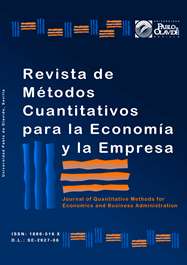Modelo de ecuaciones estructurales para determinar la intención de emprendimiento de estudiantes de posgrado
DOI:
https://doi.org/10.46661/revmetodoscuanteconempresa.3715Palabras clave:
actitud emprendedora, conducta emprendedora, control del comportamiento, determinantes de la intención, emprendimiento, espíritu emprendedor, estudiantes de posgrado, intención de emprendimiento, teoría del comportamiento planificadoResumen
En el presente trabajo de investigación se aborda, a través de la utilización de estadísticos y la revisión de literatura científica, el estudio de los determinantes de la intención de emprendimiento, tomando como caso de estudio a los estudiantes de posgrado de la Facultad de Ciencias Administrativas de la Universidad Técnica de Ambato, basándose en la Teoría del Comportamiento Planificado propuesto por Ajzen en el año 1991. De esta manera, se identifica cómo en el ámbito formativo, ciertos factores influyen de diferente manera, para generar la intención emprendedora. El estudio realizado permite conocer además las distintas percepciones que tienen los estudiantes acerca del emprendimiento y su tendencia a generar o no, un negocio propio.
Descargas
Citas
Carlos, C., Contreras, L., Silva, M., & Liquidano, M. (2015). El Espíritu Emprendedor y un Factor que Influencia su Desarrollo Temprano. Conciencia Tecnológica, 49, 46-51.
Cupani, M. (2012). Análisis de Ecuaciones Estructurales: conceptos, etapas de desarrollo y un ejemplo de aplicación. Tesis, 1, 186-199.
Escobedo, M., Hernández, J., Estebané, V., & Martínez, G. (2016). Modelos de Ecuaciones Estructurales: Características, Fases, Construcción, Aplicación y Resultados. Ciencia & Trabajo, 18(55), 16-22.
Formichella, M., & Massigoge, J.I. (2004). El concepto de emprendimiento y su relación con la educación, el empleo y el desarrollo local. VII Congreso de Administración.
González, M., Valantine, I., Pérez, C., Aguado, S., Calabuig, F., & Crespo, J. (2016). La influencia del género y de la formación académica en la intención de emprender de los estudiantes de ciencias de la actividad física y el deporte. Intangible Capital, 12(3), 759-788.
Guzmán, F., García, B., Rodríguez, L., & Alonso, M. (2014). Actitud, norma subjetiva y control conductual como predictores del consumo de drogas en jóvenes de zona marginal del norte de México. Frontera Norte, 26(51), 53-74.
Jaramillo, L. (2008). Emprendimiento: Concepto básico en competencias. Lumen, 7, 1-6.
Leite, E., Sánchez-Fernández, M., Leite, E., & Bezerra Correia, E. (2015). El espíritu emprendedor: condicionantes para la innovación. Holos, 5, 278-291.
Leyva, O., & Olague, J. (2014). Modelo de Ecuaciones Estructurales por el Método de Mínimos Cuadrados Parciales (Partial Least Squares-PLS). En M. Asensi, R. Cotarelo, M. Echenique, J. Fernández, P. Oñate, J. Romero, & J. Tamayo, Métodos y Técnicas Cualitativas y Cuantitativas Aplicables a la Investigación en Ciencias Sociales. México: Tirant Humanidades.
López, J., & Ruiz-Ruano, A. (2014). Modelado de la intención emprendedora con redes bayesianas. Revista de Psicología, 23(2), 71-87.
Malebana, J. (2014). Entrepreneurial intentions of South African rural university students: A test of the theory of planned behaviour. Journal of Economics and Behavioral Studies, 6(2), 130-143.
Marulanda, F., & Morales, S. (2016). Entorno y motivaciones para emprender. Escuela de administración de negocios, 81, 12-28.
Marulanda, F., Montoya, I., & Vélez, J. (2014). Teorías motivacionales en el estudio del emprendimiento. Pensamiento & Gestión, 36, 206-238.
Morales, A., & Ariza, A. (2012). Valores, actitudes y motivaciones en la juventud ante el emprendimiento individual y colectivo. Revista de Estudios Cooperativos, 112, 11-35.
Osorio, F., & Londoño, J. (2015). Intención emprendedora de estudiantes de educación media: extendiendo la teoría de comportamiento planificado mediante el efecto exposición. Cuadernos de Administración, 28(51), 103-131.
Parra, L., & Fleitas, M. (2010). Incubación de proyectos para iniciativas empresariales en la Universidad Libre de Cali. Dirección, 31(3), 1-8.
Rueda, I., Fernández-Laviada, A., & Herrero, Á. (2013). Aplicación de la teoría de la acción razonada al ámbito emprendedor en un contexto universitario. Investigaciones Regionales, 26, 141-158.
Ruiz, M., Pardo, A., & San Martín, R. (2010). Modelos de ecuaciones estructurales. Papeles del Psicólogo, 31(1), 34-45.
Soria-Barreto, K., Zuniga-Jara, S., & Ruiz-Campo, S. (2016). Educación e Intención Emprendedora en Estudiantes Universitarios: Un Caso de Estudio. Formación Universitaria, 9(1), 25-34.
Valencia, A., Cadavid, L., Ríos, D., & Awad, G. (2012). Factores que inciden en las intenciones emprendedoras de los estudiantes. Revista Venezolana de Gerencia, 17(57), 132-148.
Ventura, R., & Quero, M. (2013). Factores explicativos de la intención de emprender en la mujer. Aspectos diferenciales en la población universitaria según la variable género. Cuadernos de Gestión, 13(1), 127-149.
Publicado
Cómo citar
Número
Sección
Licencia
Derechos de autor 2020 Revista de Métodos Cuantitativos para la Economía y la Empresa

Esta obra está bajo una licencia internacional Creative Commons Atribución-CompartirIgual 4.0.
El envío de un manuscrito a la Revista supone que el trabajo no ha sido publicado anteriormente (excepto en la forma de un abstract o como parte de una tesis), que no está bajo consideración para su publicación en ninguna otra revista o editorial y que, en caso de aceptación, los autores están conforme con la transferencia automática del copyright a la Revista para su publicación y difusión. Los autores retendrán los derechos de autor para usar y compartir su artículo con un uso personal, institucional o con fines docentes; igualmente retiene los derechos de patente, de marca registrada (en caso de que sean aplicables) o derechos morales de autor (incluyendo los datos de investigación).
Los artículos publicados en la Revista están sujetos a la licencia Creative Commons CC-BY-SA de tipo Reconocimiento-CompartirIgual. Se permite el uso comercial de la obra, reconociendo su autoría, y de las posibles obras derivadas, la distribución de las cuales se debe hacer con una licencia igual a la que regula la obra original.
Hasta el volumen 21 se ha estado empleando la versión de licencia CC-BY-SA 3.0 ES y se ha comenzado a usar la versión CC-BY-SA 4.0 desde el volumen 22.










